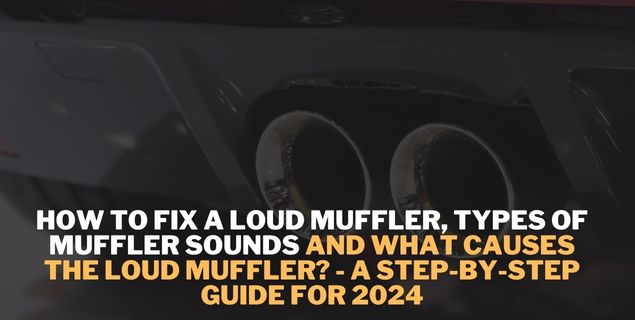Discover how to fix a loud muffler with our comprehensive step-by-step guide for 2024. Explore the types of muffler sounds, understand what causes a loud muffler, and learn effective solutions to address excessive noise. Whether it’s muffler repairs or upgrades, our guide provides insights into maintaining an optimal exhaust system and staying compliant with local regulations.
How to Fix a Loud Muffler: A Step-by-Step Guide for 2024
Identify the Source of the Noise:
Before diving into the repair process, it’s essential to identify the source of the loud muffler. Inspect the entire exhaust system for any visible damage, such as holes, cracks, or loose components. Pay close attention to the muffler itself, as well as the pipes and connections.
Check for Loose Hangers:
Loose or damaged hangers can contribute to a loud muffler. Inspect the exhaust hangers for any signs of wear or breakage. Replace any damaged hangers and ensure that the entire exhaust system is securely supported.
Examine the Muffler for Holes or Leaks:
A common cause of loud mufflers is the presence of holes or leaks. Carefully inspect the muffler for any visible openings. If holes are detected, consider using a high-temperature epoxy or muffler patch kit to seal them. For larger or more extensive damage, it may be necessary to replace the muffler.
Tighten Loose Bolts and Connections:
Over time, bolts and connections in the exhaust system can become loose, leading to increased noise. Use a wrench to tighten any loose bolts, clamps, or connections. Ensure that all components are securely fastened to eliminate potential points of noise.
Replace a Damaged Muffler:
If the muffler is beyond repair due to extensive damage, consider replacing it with a new one. Choose a muffler that is compatible with your vehicle’s make and model. The replacement process typically involves unbolted the old muffler and securing the new one in its place.
Install a Muffler Silencer:
For those looking to reduce noise levels without replacing the entire muffler, a muffler silencer can be a viable solution. These devices are designed to minimize sound output without compromising exhaust flow. Install the silencer according to the manufacturer’s instructions.
Inspect the Catalytic Converter:
A malfunctioning catalytic converter can also contribute to excessive noise. Inspect the converter for any signs of damage or clogs. If issues are detected, it may be necessary to replace the catalytic converter to restore proper functionality.
Consider Professional Assistance:
If you are unable to identify or address the issue on your own, seeking professional assistance from a qualified mechanic is advisable. A professional can perform a comprehensive inspection of the exhaust system and provide expert guidance on the most appropriate repairs.
Regular Maintenance Practices:
To prevent future muffler issues, adopt regular maintenance practices for your vehicle’s exhaust system. This includes checking for rust, addressing small issues promptly, and ensuring that all components are securely fastened.
Utilize Quality Exhaust Products:
When replacing or repairing components of the exhaust system, opt for high-quality and durable products. Quality mufflers, pipes, and hangers can contribute to a longer-lasting and quieter exhaust system.
Types Of Muffler Sounds
Stock Muffler Sound:
Most factory-installed mufflers are designed to produce a quiet and unobtrusive sound. They aim to meet noise regulations and provide a smooth driving experience without drawing too much attention.
Performance Muffler Sound:
Aftermarket performance mufflers are often installed to enhance the exhaust note and improve the vehicle’s overall performance. These mufflers may produce a deeper, more aggressive tone compared to stock mufflers.
Straight-Through Muffler Sound:
Straight-through or glass pack mufflers have a simple design with a perforated tube surrounded by sound-deadening material. They often produce a loud and deep exhaust note, giving the vehicle a more aggressive sound profile.
Chambered Muffler Sound:
Chambered mufflers use internal chambers to reflect sound waves and reduce noise. Depending on the design, they can produce a distinctive tone, ranging from a deep rumble to a more refined and mellow sound.
Turbo Muffler Sound:
Turbo mufflers are designed to provide a balance between performance and sound reduction. They often produce a moderately aggressive exhaust note, making them popular among enthusiasts seeking a sportier sound without excessive noise.
Resonator-Enhanced Sound:
Some vehicles incorporate resonators in addition to mufflers. Resonators can help fine-tune the exhaust note by eliminating certain frequencies or enhancing others, resulting in a unique and pleasing sound.
High-Performance Muffler Sound:
High-performance or racing mufflers are engineered for maximum exhaust flow and power gains. These mufflers often produce a loud and aggressive sound, suitable for track-oriented or high-performance vehicles.
Customized Sound:
Enthusiasts may choose to customize their exhaust systems by combining different mufflers, resonators, and other components to achieve a unique sound signature tailored to their preferences.
What Causes The Loud Muffler?
A loud muffler is typically the result of various factors related to the design and condition of the exhaust system. Here are some common reasons why a muffler may produce a loud or aggressive sound:
Aftermarket Performance Mufflers:
Upgrading to an aftermarket performance muffler is a common way to achieve a louder and more aggressive exhaust note. Performance mufflers are designed to maximize exhaust flow and often have less sound-dampening material compared to stock mufflers.
Straight-Through Design:
Mufflers with a straight-through design, such as glasspacks, allow exhaust gases to flow more freely. This design can result in a louder and deeper exhaust tone, as there is less restriction to the flow of gases.
Exhaust System Modifications:
Customizing the exhaust system by removing resonators or installing larger-diameter pipes can contribute to increased noise levels. These modifications alter the way sound waves travel through the exhaust system, often leading to a louder overall exhaust note.
Worn or Damaged Muffler:
Over time, mufflers can deteriorate due to rust, corrosion, or internal damage. A damaged or worn-out muffler may lose its ability to effectively reduce sound, resulting in a louder exhaust.
Holes or Leaks:
Any holes or leaks in the exhaust system can allow exhaust gases to escape more freely, contributing to increased noise levels. This can occur due to corrosion, physical damage, or poor installation.
Engine Modifications:
Performance modifications to the engine, such as aftermarket headers or a high-flow catalytic converter, can affect the exhaust sound. These modifications often lead to a more aggressive exhaust note, especially when combined with other changes in the exhaust system.
Resonance and Harmonics:
The interaction of sound waves within the exhaust system can create resonance and harmonics, influencing the perceived loudness and tone of the exhaust. Changes in the exhaust system design can alter these acoustic properties.
Turbochargers and Superchargers:
Vehicles equipped with turbochargers or superchargers can produce unique exhaust sounds. The forced induction process can result in a louder and more pronounced exhaust note, especially during acceleration.
Conclusion:
Fixing a loud muffler requires a systematic approach to identify and address the root cause of the issue. By following this step-by-step guide for 2024, you can effectively silence the annoying noise and ensure that your vehicle’s exhaust system operates optimally. Whether it’s tightening loose connections, sealing holes, or replacing damaged components, taking proactive measures will contribute to a quieter and more enjoyable driving experience.

